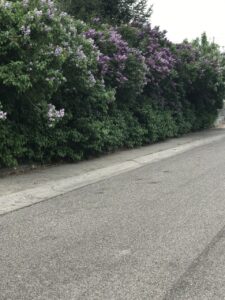 The aroma of lilacs wafts its way to me as I step out of my car at my daughter’s house. A row of lilacs in full bloom lines the sidewalk. My mind travels back to when I was young and I remember cutting bunches of lilacs. It is Memorial Day and we are going to the cemetery to decorate the graves. My mother always hopes that the lilacs will be in bloom for Memorial Day, and this year they are.
The aroma of lilacs wafts its way to me as I step out of my car at my daughter’s house. A row of lilacs in full bloom lines the sidewalk. My mind travels back to when I was young and I remember cutting bunches of lilacs. It is Memorial Day and we are going to the cemetery to decorate the graves. My mother always hopes that the lilacs will be in bloom for Memorial Day, and this year they are.
We have been preparing for Memorial Day for several weeks. Making crepe paper flowers is a big project. Two circles of crepe paper and a wire make a sweet pea—a good beginning project for a young child. I use an orange circle and a blue circle to make a two-toned sweet pea. My older brother informs me that those aren’t the right colors, but my older sister upholds my right to choose the colors I want. As I get older, I graduate to making crepe paper roses. I learn to use a table knife to curl the edges of the petals, and I carefully stretch each petal to form a cup. My first flowers don’t look right. The wire is not wrapped tight enough around the petals and so they fall from my fingers. But I persist and learn. My older sister makes the carnations. They are the hardest to make.
When the flowers are finished, my sister melts paraffin wax. She places a tin can containing the wax in a pan of water on the stove. She explains that if she put the can directly on the burner, the wax could burst into flame. I am an observer of this process of melting the wax, but I am allowed to help dip the flowers in the wax. The wax hardens and the flowers are shiny. Now they will last longer.
On the morning of Memorial Day, we get ready to go to the cemetery. Shovels and hoes are loaded in the trunk of the car so the graves can be weeded and mounded up again. Lilacs are cut and placed in buckets of water. We twist the crepe paper flowers into wreaths and sprays. Three identical wreaths with roses are made for the graves of Grandpa Bingham and his two wives. Three sweet pea sprays are made for the baby graves that are in the Bingham Cemetery plot. We have made other wreaths, but I forget who they were for.
After the graves are decorated, the adults visit with relatives and friends who have also come to the cemetery to decorate the graves of their loved ones. My sister and I wander the cemetery. We like the tombstone with the little lamb on top. We read the inscriptions and look at the row after row of graves with small American flags by them. These are the graves of soldiers who died defending our country.
Many years and miles separate me from that cemetery. My parents and other relatives have now been laid to rest there. My own life is farther from its beginning and closer to its end.
I contemplate my future tombstone. It will record my name, birth and death information. But that isn’t the most important thing that will be recorded there. The most important thing will be the dash between birth and death. That one little punctuation mark will represent the whole of my life—the years between my birth and death. And it isn’t the time span it represents—but the quality of those years—that is important. How did I live? My fame—or non-fame doesn’t matter. What will I leave behind? Did I serve? Did I give? Did I love?
The stories that I have told are just words unless they have touched another, bringing joy, happiness, healing. The pictures I paint are just colors on a page. The words I write will vanish and be lost unless they matter to someone else. My life is a dash between birth and death. What will that dash represent?
